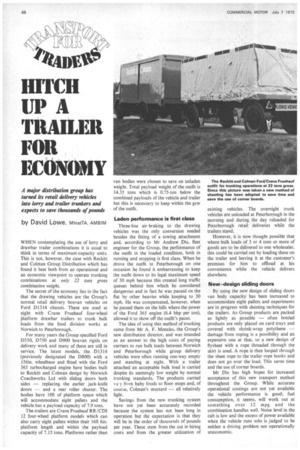MUM
Page 70

If you've noticed an error in this article please click here to report it so we can fix it.
Up A .
TRAILER FOR .
ECONOMY
A major distribution group has turned its mufti delivery vehicles into lorry and trailer trwtkers and expects to save thousands of pounds
by David Lowe, MInstTA, AMBIM
WHEN contemplating the use of lorry and drawbar trailer combinations it is usual to think in terms of maximum-capacity units. This is not, however, the case with Reckitt and Colman Group Distribution which has found it best both from an operational and an economic viewpoint to operate trunking combinations at only 22 tons gross combination weight.
The secret of the economy lies in the fact that the drawing vehicles are the Group's normal retail delivery boxvan vehicles on Ford D1314 chassis. These are used at night with Crane Fruehauf four-wheel Platform drawbar trailers to trunk bulk loads from the food division works at Norwich to Peterborough.
For many years the Group specified Ford D550, D750 and D900 boxvan rigids on delivery work and many of these are still in service. The latest models, the D1314 (previously designated the D800) with a 156in. wheelbase and fitted with the Ford 365 turbocharged engine have bodies built to Reckitt and Colman design by Norwich Coachworks Ltd with sliding doors both sides — replacing the earlier jack-knife doors — and a rear roller shutter. The bodies have 18ft of platform space which will accommodate eight pallets and the vehicle has a payload capacity of 7.9 tons.
The trailers are Crane Fruehauf RB /CDT 12 four-wheel platform models which can also carry eight pallets within their 16ft 6in. platform length and within the payload capacity of 7.15 tons. Platforms rather than van bodies were chosen to save on unladen weight. Total payload weight of the outfit is 14.35 tons which is 0.75-ton below the combined payloads of the vehicle and trailer but this is necessary to keep within the gcw of the outfit.
Laden performance is first class Three-line air-braking to the drawing vehicles was the only conversion needed besides the fitting of a towing attachment and, according to Mr Andrew Dix, fleet engineer for the Group, the performance of the outfit in the loaded condition, both in running and stopping is first class. When he drove the outfit to Peterborough on one occasion he found it embarrassing to keep the outfit down to its legal maximum speed of 30 mph because this created long traffic queues behind him which he considered dangerous and in fact he was passed on the flat by other heavies while keeping to 30 mph. He was compensated, however, when he passed them on the hills where the power of the Ford 365 engine (6.4 bhp per ton), allowed it to show off the outfit's paces.
The idea of using this method of trunking came from Mr A. F. Menzies, the Group's new distribution director, and was intended as an answer to the high costs of paying carriers to run bulk loads between Norwich and Peterborough while group delivery vehicles were often running one-way empty and standing at night. With a trailer attached an acceptable bulk load is carried despite its seemingly low weight by normal trunking standards. The products carried va..y from baby foods to floor mops and, of course, Colman's mustard — all relatively light.
Savings from the new trunking system have not yet been accurately recorded because the system has not been long in operation but the expectation is that they will be in the order of thousands of pounds per year. These stem from the cut in hiring costs and from the greater utilization of existing vehicles. The overnight trunk vehicles are unloaded at Peterborough in the morning and during the day reloaded for Peterborough retail deliveries while the trailers stand.
However, it is now thought possible that where bulk loads of 3 or 4 tons or more of goods are to be delivered to one wholesaler, this could be carried out by loading these on the trailer and leaving it at the customer's premises for him to offload at his convenience while the vehicle delivers elsewhere.
New-design sliding doors
By using the new design of sliding doors van body capacity has been increased to accommodate eight pallets and experiments are in progress with sheeting techniques for the trailers. As Group products are packed as lightly as possible — often bottled products are only placed on card trays and covered with shrink-wrap polythene — damage from roping is a possibility and an expensive one at that, so a new design of flysheet with a rope threaded through the skirt is used. A rope is then looped through the sheet rope to the trailer rope hooks and does not go over the load. This saves time and the use of corner boards.
Mr Dix has high hopes for increased acceptance of this new transport method throughout the Group. While accurate operational costings are not yet available the vehicle performance is good; fuel consumption, it seems, will work out at something over 12 mpg and the combination handles well. Noise level in the cab is low and the excess of power available when the vehicle runs solo is judged to be neither a driving problem nor operationally uneconomic.
















































































































































